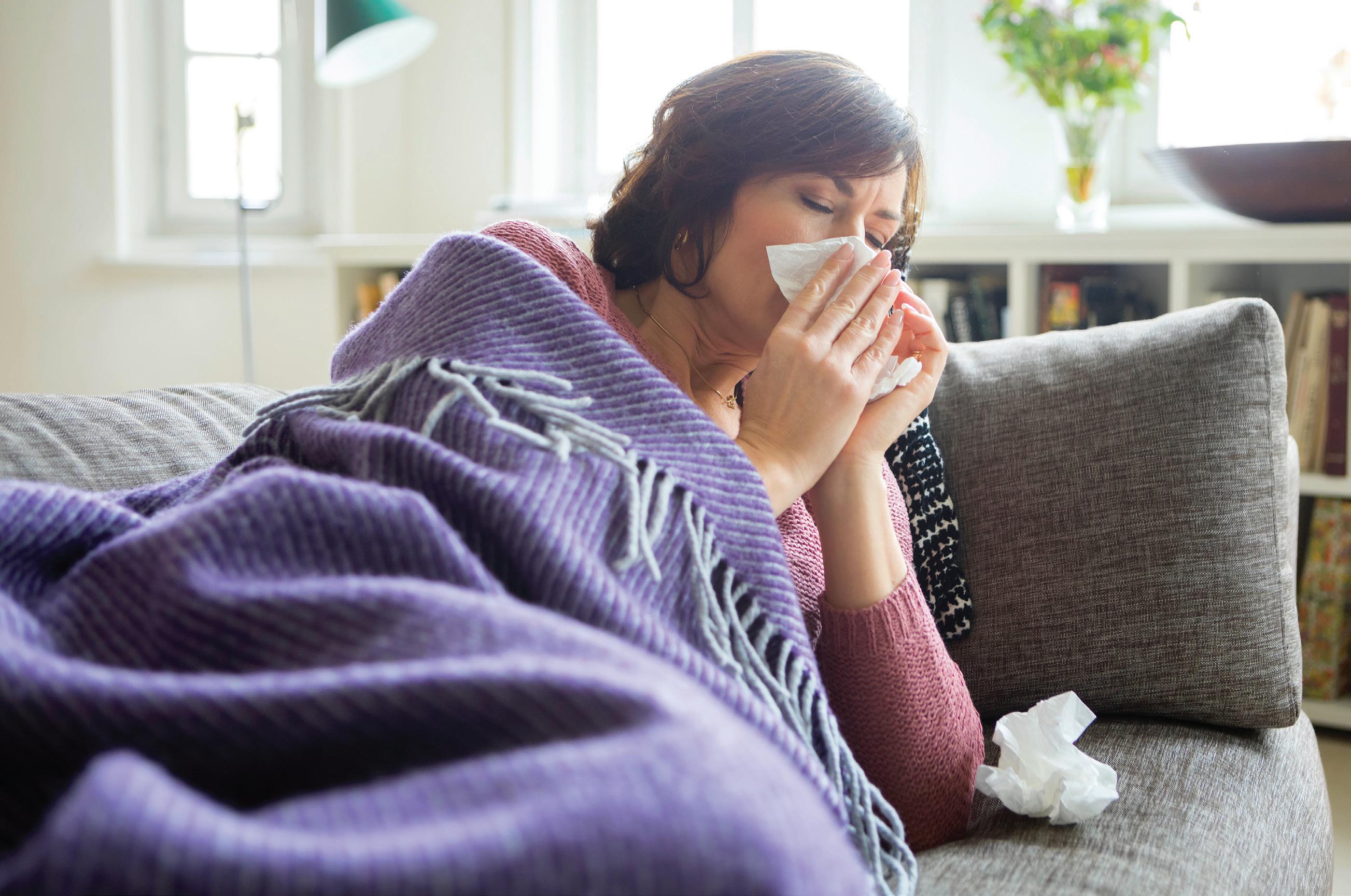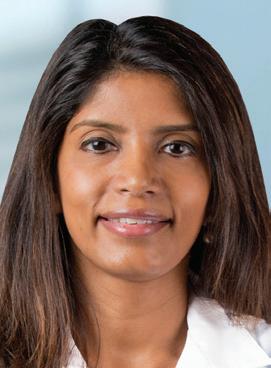

LEADING MEDICINE

HOW TO PREPARE FOR THIS YEAR’S RESPIRATORY VIRUSES

The respiratory or flu season begins in the fall and continues through early spring.
According to Dr. Malika Stewart, boardcertified primary care physician with Houston Methodist Primary Care Group at Rosenberg, you can prepare for the seasonality of respiratory viruses, including influenza and respiratory syncytial virus (RSV).
BEST VIRUS PROTECTION? GET VACCINATED
“I recommend getting vaccinated to reduce your risk of symptomatic infection, though you should check with your doctor,” Stewart emphasized. “Everyone should get his or her annual flu shot by mid-October, though it’s never too late to get vaccinated.”
RSV vaccines are available for those most vulnerable to developing serious illness: older adults and infants. Adults over 60 are eligible for the RSV vaccine and should consider getting inoculated before heading into the respiratory season. The vaccine is also available for pregnant women late in their pregnancies to help protect newborns from RSV. Consult your doctor for your specific vaccine eligibility.
IS IT THE FLU OR RSV?
If you do get sick, it can be difficult to determine if it’s the flu or RSV since symptoms are similar — including fever and dry cough. But testing is available for these viruses.
“Medications are available to treat the flu, so getting tested is crucial to help guide prompt, effective treatment,” Stewart stressed.
There are prescription oral antiviral treatments for the flu, even in pediatric doses. “The options are limited for treating a cold, but testing is necessary to keep someone with RSV from receiving a flu antiviral or unnecessary antibiotics,” Stewart explained.
The bottom line: If you’re feeling ill, call your doctor. Your specific symptoms will help your physician determine which test is right for you.
FEELING SICK? STAY HOME
Viruses that spread during the respiratory season are transmitted the same way — from person to person through droplets we release as we cough, sneeze and speak.
By staying home when you are sick, you help reduce the chance of inadvertently passing a respiratory bug along to someone more vulnerable and at higher risk of getting very sick, including hospitalization.
“If you have symptoms, a good course of action is to stay home, but call your primary care doctor if you start to feel worse,” Stewart added. •
Your Health Partner
Houston Methodist provides primary care that’s personalized for you and your unique needs. To schedule an appointment or find a primary care doctor near you, visit houstonmethodist.org/ pcg/southwest or call 713.441.7965.
Dr. Malika Stewart

Can You Reverse Coronary Artery Disease?

Coronary artery disease (CAD) is a type of heart disease that affects the arteries responsible for supplying oxygen-rich blood to the heart muscle. It happens when fatty deposits called plaque accumulate within the arteries, a process known as atherosclerosis.
“These plaque deposits can narrow and harden your arteries,” explained Dr. Wafi A. Momin, cardiologist at Houston Methodist Cardiology Associates at Sugar Land. “This keeps blood from reaching your heart muscle and can lead to life-threatening complications.”
Chest pain is the most common CAD symptom. But shortness of breath and indigestion can also be early signs of blockage. Left untreated, CAD can lead to additional complications, including arrhythmia and congestive heart failure.
PREVENTION IS KEY
Making healthier changes, including increasing your physical activity, can help limit your risk of CAD. You can also try the Mediterranean diet, which is rich in veggies, fruits, whole grains and olive oil (see sidebar). A few extra food tips that can help include:
■ Avoiding saturated fats: cheese, butter and fatty meat
■ Skipping starchy carbs: potatoes, white bread and baked goods
■ Prioritizing complex carbs: quinoa, oats and brown rice
You can also get a coronary artery calcium (CAC) scan. If the CAC scan reveals a significant plaque burden, your doctor may recommend statins and perhaps even aspirin, in addition to lifestyle changes.
“Unfortunately, plaque buildup can’t be reversed,” Momin explained. But effective management of CAD can help prevent further buildup.
MANAGING THE DISEASE
Statins, a type of cholesterol medication, not only lower
cholesterol levels but also stabilize plaque and reduce inflammation in the arteries.
Additionally, your doctor may recommend medications such as beta-blockers to alleviate stress on the heart muscle, while low-dose aspirin may be prescribed to prevent blood-clot formation.
“While it’s best to prevent heart disease completely by adopting a healthy lifestyle, the situation for CAD patients isn’t hopeless,” Momin emphasized. “Medications and therapies are available, and lifestyle changes can transform your outlook. It’s important to follow your doctor’s recommendations.” •
What Is the Mediterranean Diet?
This diet is based on the eating habits of the countries bordering the Mediterranean Sea. There’s not one standard Mediterranean diet, but a few of the common rules include:
Every meal: fruits, veggies, whole grains, olive oil
Three servings a week: fish, seafood, nuts
One serving a day: poultry, eggs, low-fat dairy
One serving a week: red meat, sweets
Take Care of Your Heart
If you are concerned about your heart health, it’s time to talk to a specialist. To schedule an appointment with Houston Methodist Cardiology Associates at Sugar Land, visit houstonmethodist.org/spg or call 281.456.3077.
Dr. Wafi A. Momin
Beating the Odds: FIGHTING BACK AGAINST BREAST CANCER

When it comes to breast cancer prevention, knowing the common breast cancer risk factors is key, including:
■ Age
■ Being overweight
■ Family history
■ Genetic mutations
“The average risk is one in eight for women who do not have a family history,” said Dr. Michelle O’Shea, board-certified surgeon at Houston Methodist Breast Surgery Partners at Sugar Land. “Your risk never goes down since risk increases with age.”
While you cannot change risk factors such as age or family history, you can take preventive actions to modify your risk.
GET YOUR ANNUAL MAMMOGRAM
Since your breast cancer risk increases with age, it’s important to have a yearly mammogram starting at age 40. At age 25, talk to your primary care provider or gynecologist to help determine your risk level and if you should start getting screened sooner. “This allows us to detect your breast cancer earlier, which improves breast cancer survival and decreases the chances you’ll have to have chemotherapy for some tumors,” O’Shea explained.

Dr. Michelle O’Shea
STAY PHYSICALLY ACTIVE
Getting 150 minutes of exercise a week is recommended. Although this can sound overwhelming, breaking up the time helps. “Thirty minutes a day over five days will really decrease your risk of developing breast cancer,” O’Shea suggested.
LIMIT ALCOHOLIC DRINKS
Limiting alcohol to three or fewer drinks per week can lower a woman’s risk. Women who consume two to five alcoholic drinks a day have about 1.5 times the risk of developing breast cancer compared to nondrinkers. “No alcohol is best to modify your risk,” O’Shea stressed.

MAINTAIN A HEALTHY WEIGHT
Women with more fat cells produce more estrogen and tend to have higher insulin levels, which are linked to increased breast cancer risk. Regular exercise and a diet with fruits, vegetables and whole grains can help keep your weight at a healthy level. “Maintaining your weight after menopause is especially tough, but being overweight after menopause can increase breast cancer risk 20-60%, according to the American Cancer Society,” O’Shea explained.
BREASTFEED LONGER
The longer you can breastfeed your baby, the better it is for your long-term breast health. “The more you breastfeed, the more it decreases your risk of developing breast cancer,” O’Shea said. While the reasons aren’t clear, one possible explanation is women who breastfeed have fewer menstrual cycles throughout their lives, and, therefore, less estrogen exposure.
ADD SUPERFOODS
Studies indicate consuming more monounsaturated fats, such as olive oil, may protect against breast cancer. Olive oil has antioxidants and anti-inflammatory properties, which can help reduce breast cancer risk. “These studies show that people with a diet higher in antioxidants have promising results,” O’Shea said.
KNOW YOUR BREAST DENSITY
Breast density is usually based on age. However, some post-menopausal women continue to have dense breasts. If you know you have dense breasts, ask for an ultrasound with your 3D screening mammogram. “This is a minimally invasive way for us to screen a dense breast and detect breast cancer,” O’Shea said.
CONSIDER GENETIC TESTING
Talk to your doctor about whether genetic testing is right for you, especially if you have a strong family history of breast cancer. Mutations in certain genes, such as BRCA1 and BRCA2, increase breast cancer risk. Women with this gene mutation may need to have more frequent screenings and may want to consider prophylactic surgery (breast removal).
EARLY DETECTION IS KEY
Getting your mammogram is important. “Most breast cancers have no signs,” O’Shea warned. “By the time you feel a lump in the breast, it could be half an inch. A mammogram can detect the tiniest lump before you can feel it,” she explained. •
WHAT TO DO IF YOU FEEL A BREAST LUMP
Your first action after feeling a breast lump is to schedule an appointment with your primary care provider. Your doctor will look for a variety of features and characteristics to answer questions such as:
• How large is the lump and does it change in size?
• Does the lump move under the fingers, or is it attached to the skin?
• Is the lump painless or painful and accompanied by red, itchy or inflamed skin?
• Is the lump affecting the nipple, causing inversion or creating discharge?
• Does the lump become more painful around your period?
• Is there more than one lump on one or both breasts?
Schedule Your Mammogram
To schedule your mammogram at a Houston Methodist Breast Care Center, visit houstonmethodist.org/mammogram-scheduling or call 346.356.PINK (7465)
LUNG CAN CER SCREENING: What You Need to Know


While the rate of new lung cancer cases is decreasing, it’s still the leading cause of cancer deaths in the U.S. But thanks to lung cancer screenings, deaths can be reduced.
“It’s important to catch lung cancer early,” said Dr. Priya Oolut, board-certified pulmonologist at Houston Methodist Pulmonary & Sleep Medicine Specialists at Sugar Land. “The prognosis when we catch it early is leaps and bounds better than when we catch it late.”
For instance, the five-year survivability of stage 1 lung cancer is about 85%. This rate drops to just 20% if lung cancer isn’t caught until stage 4.
“Unfortunately, lung cancer doesn’t always show symptoms early on, so that’s why we recommend lung cancer screenings for those who qualify,” Oolut added.
DON’T IGNORE SYMPTOMS
Everyone should take lung cancer symptoms seriously, which include:
■ Chest pain that can’t be explained by other findings
■ Chronic cough
■ Coughing up blood
■ Unintentional weight loss
“If you have any symptoms of lung cancer it’s important to see a doctor right away,” Oolut said.
HOW A SCREENING WORKS
Lung cancer screening requires only a low-dose CT scan, meaning less radiation is needed than during a regular CT scan, and an IV isn’t needed. The screening is covered by insurance for those who meet eligibility criteria. (see sidebar)
“The entire process only takes 30 seconds,” Oolut explained. “Patients just have to lie still for that time.”
If something looks abnormal on a CT scan, the next step is for your doctor to take a biopsy. With a lung biopsy there is a risk of complications, so doctors only perform the procedure when needed. Fortunately, biopsy technology has improved, making today’s procedure much safer.
DON’T DELAY GETTING SCREENED
Though a very efficient tool, adherence to lung cancer screening is a challenge.
“Currently, fewer than 10% of individuals who are eligible for screening are getting screened,” Oolut said. “We want to boost these numbers and catch more incidents of lung cancer.”
Whether it’s anxiety about the possibility of a positive lung cancer result or guilt about your current or past smoking history, don’t let anything keep you from coming in for screening if you’re eligible. •
LU NG CANCER
SCREENING
CRITERIA: WHO SHOULD GET TESTED ?
Most health insurance plans cover lung cancer screenings, provided you meet the following criteria:
■ Between the ages of 50-80
■ A current smoker or have quit within the last 15 years
■ A 20-pack-year history (multiply the number of packs per day by the number of years smoked) The screening costs $225 for the uninsured or for those who don’t want to use insurance. Your primary care doctor will need to order the screening.
To find out if you qualify for lung cancer screening, talk with your primary care physician, visit houstonmethodist.org/lung-screening or call 713.441.LUNG (5864)
Dr. Priya Oolut
No Need to Put Off Hip Replacement Surgery: Advances in Robotic Surgery

Sixty-year-old Donna Jensen slept on a recliner in her living room for a whole year. The pain in her hips was too overwhelming to sleep in a bed. But thanks to roboticassisted hip replacement surgery, Jensen is back to sleeping in her own bed.
Dr. Matthew Pearl, orthopedic surgeon with Houston Methodist Orthopedics & Sports Medicine at Sugar Land, performed the surgery with a technologically advanced robotic system — the first time it was used in a Fort Bend County hospital.
STATE-OF-THE-ART TECHNOLOGY
The state-of-the-art robotic hip and knee replacement tool enhances precision, may reduce recovery times and provides patients with a new standard of care for joint replacement procedures.
This robotic system uses 3D CT-based planning technology to make exact cuts and data analytics. “This helped plan and allowed for a more accurate implant position of Donna’s new hip,” explained Pearl.
MADE FOR HIGH-RISK PATIENTS
“Donna’s case wasn’t easy,” Pearl said. “She was at an increased risk for complications because of her history of spinal fusion and advanced arthritis.”
The new robotic technology may reduce complications and improve outcomes for high-risk anatomy patients: those suffering from abnormalities in thigh bones, degenerative disease, prior traumas to the pelvis and bone loss.
“Using this technology, I was more confident that we did everything we could to reduce her risk,” Pearl added. “The addition of robotic technology for hip and knee replacements reaffirms our commitment to delivering the highest quality health care services to our community.”
“The first night I was home from the hospital, I slept in my own bed and was nearly in tears,” Jensen said. “I haven’t been able to sleep in the same bed as my husband for over a year. I also can now stand in my kitchen and chop vegetables. It’s something so small, but I would have to drag a bar stool around with me in the kitchen to cook.”
PERSONALIZED TREATMENT
Pearl, along with his orthopedic surgeon colleagues, Dr. Ashvin Dewan and Dr. Thomas Rivers, use the new robotic technology to personalize treatment and enhance their patients’ quality of life. With the use of this advanced technology, surgeons design customized treatment plans that may improve patient results. Jensen was hesitant at first, afraid the surgery wouldn’t work because of her age and overall health. “If I would have known, I would have done it sooner,” she said. •
Know Your Options

If you want to learn more about robotic surgery options, we can help. To schedule an evaluation, visit houstonmethodist.org/jointpain or call 281.690.4678
Dr. Matthew Pearl



Early Detection Starts With Your

Early Detection Starts With Your ANNUAL


















The recommended age to start your annual mammogram is 40. Schedule yours today.
At Houston Methodist Breast Care Centers, our board-certified experts use the latest imaging technology to provide you with cutting-edge breast screenings — such as 3D mammograms — to detect even the smallest lumps and abnormalities with accuracy. We offer:
• 10+ convenient locations across Houston
• Online scheduling with readily available appointments
• Expanded hours available at most locations
• Access to medical records and test results through MyChart







Scan Code to Schedule Your Mammogram houstonmethodist.org/mammogram-scheduling 346.356.PINK (7465)
We do not require a doctor’s order for your annual screening mammogram.
